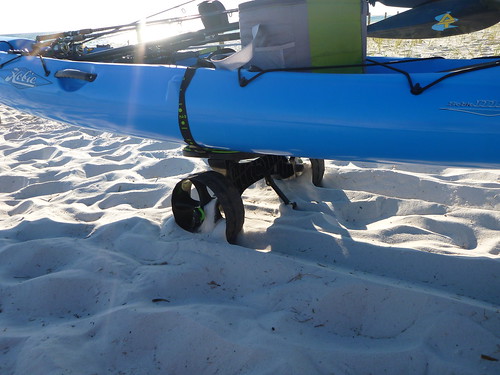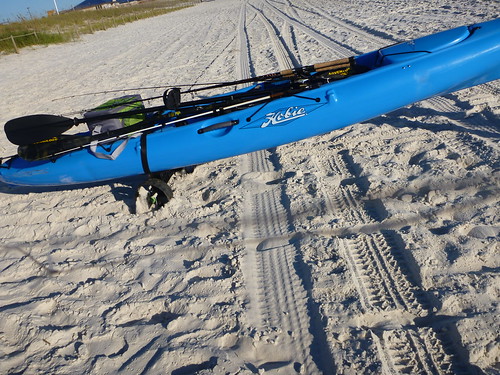When I go to buy equipment I do a lot of research, because I want the best there is. I don’t want equipment failures due to cheap products manufacturing defects, or impurities that could result in injuries to me, someone else, or any equipment. I was in the market for a cart and kept eyeballing the C-Tug Cart. It looked to be the perfect cart due to its ability to transform to almost any hull with pivoting pads for your special craft to rest on.
I was in need of a cart because there are many places that I fish that I’m unable to drive to, and must carry or drag into. I like to keep my equipment in the best condition possible so I prefer not to drag, and man created the wheel thousands of years ago to make life easier.
I bought my C-Tug Cart in April of 2011, and was able to use it a few times. The first trip was to a float on the Elk River here in Tennessee. The access road has been blocked off so no vehicular traffic can pass so its foot traffic only. I was running about 20 minutes late, and when I got there my three buddies that I was fishing with were already halfway down the 500+yard access road. They were taking turns carrying their kayaks with their gear loaded in so about 115lbs per kayak and 12’-13’ long. They would carry them with one guy in front and one guy in the rear 60-70 yards at a time and then get the other kayak and kinda do a leap frog thing. You don’t want to leave your gear unattended or out of sight in most areas.
I arrived and assembled the C-Tug (takes less than 30 seconds on a slow day) then set my Jackson Coosa on the cart where the cart was about even with the seat. Then I loaded up all my gear in and on the kayak. Total weight I guess was around 150lbs (I carry excess gear to be prepared for any situation). I started pulling/guiding my kayak on the cart down the path. The mosquito’s were so bad they were flying in my mouth, nose, and ears. They were feeding thru my shirt, and just about everywhere else. I could spot 30 or more on me and those were the places I could see. The cart pulled great and, my buddies ended up using my cart for a trade off of some DEET before getting on the water, and they really liked the cart. Once on the water the mosquitoes were nowhere to be seen.
There are two types of tires for this cart. One is pneumatic which my cart came with, and the others are solid.
The pneumatic tires can be difficult to inflate (due to a short valve stem), and prone to punctures. I’ve not had any issues with the pneumatic tires, but that’s just what I’ve read. If you are using the inflatable tires I recommend a valve stem extension.
Later in the year solid tires came available and we purchased them before another trip to the Florida Panhandle. Before our trip I had these wheels thru the mud, over rocks, on pavement, over curbs, thru grass, and about everywhere I could think of. I found that I liked the added stability of the hard wheels as they have more surface area, and slightly wider stance. On our trip to Florida we took several different kayaks. I found that the Hobie Revolution was easier pulled without the cart in the extremely soft sands, and the Pro Angler was easier used with the cart. I think it’s due to the differences in weight, and surface area of the hull that makes one easier to pull across sand without the cart. The extremely soft sand of the Gulf is the only place where I’ve found the C-Tug difficult to use with particular kayaks.


Several things I like about the C-Tug are that it breaks down into 6 parts quickly for easy storage in the hull or in a milk crate. The cart is made of a very rigid plastic so you have no corrosion, and it’s very strong. I’ve loaded close to 300lbs on this cart and have had no problems. I’ve hauled up to two kayaks on the cart at one time with the assistance of the long web straps that the cart comes with. The pads that the kayak or canoe sits on swivel they form to the contour of your hull so you have more surface area of your hull being supported. The pads also have a rubberized surface that grip to the bottom of the vessel.
I wish there were better straps available because I find that the straps seem difficult to fully tighten.
The C-Tug cart isn’t cheap the cart with the pneumatic tires is $159.90, and with the hard wheels $169.90. If you replace the pneumatic wheel it will cost you $18.50 each, and to replace the solid wheel will cost $24.50 each.
My preference is the solid wheels due to being puncture resistant, more stable, lighter, and less maintenance.
9 thoughts on “C-Tug Cart Review”
Comments are closed.

Nice review. I have been looking at the C Tug for a while.
Thanks
Marty
Great review. We are set to have these in stock at HOOK 1 by late winter/early spring!! – Chad
+1
Thanks for the review. How are the rigid tires for going over tree roots, rocks, drop-offs, etc.? Or would you recommend the pneumatic tires for rough, woodland terrain, paths that have been scoured by use and drainage, etc.?
Mark,
The pneumatic tires do absorb more shock than the solid aka Beach Tires, but I’ve found that when going over rocks, roots, and other uneven surfaces I need the wider beach tires for more stability rather than the pneumatic tires to absorb the shock. Not saying that the pneumatic tires are no good, just saying that if you are going heavy (heavy kayak loaded) I want the most stability I can get. If I were just going to use this cart on hard even surfaces the pneumatic tires would be just fine with me.
Jeremy
Thanks for the review on the C-TUG Kayak & Canoe cart.
To date the new “Kiwi” Wheel (aka the Hard Wheel) accounts for more than 70% of sales in North America after the first full year on the market.
C-TUG is still winning design awards and it is our promise to users continue to make improvements to the cart, wheels and our straps – keep an eye on our site in mid- 2012.
Regards
Peter McColl
C-TUG North America
Just received my c-tug with hard wheels.After reading the reviews I’m confident I made the right choice.Thanks B.W.
C-Tug has just recently released a set of adapters to the puncture free wheels that make the wheels wider they are called the Sidewinder. I can’t wait to get a set of these, I think they would be great for the Florida sand.
http://www.c-tug.com/products/sidewinders